
|
Yankee Stadium was the first structure to be called a stadium, and it remains the world’s most famous eight decades after it opened.
The large, horseshoe shaped ballpark is one of baseball’s most hallowed grounds and from the moment it opened in 1923 the home of the Yankees has been synonymous with championships. Prior to moving into Yankee Stadium, which was built in just 284 days, New York had never won a World Series. That streak ended in the Stadium’s first year of business when the Yankees defeated the Giants in six games, the first of 26 titles for the pinstriped bunch from the Bronx. Despite its historical significance - and hosting 37 World Series is more than significant - Yankee Stadium is actually a big, relatively bland place that only draws it’s mystique from the success of the home team and the legendary men who played there. Among the Stadium’s most notable features is Monument Park, where numerous monuments and plaques have been built to honor Yankee greats. Up until the 1970s the monuments were in fair play, but they now take up residence behind the left-center field fence between the bullpens. In front of the visiting team’s bullpen is a walkway dedicated to the 16 players and managers who have had their number retired by the Yankees. New York was the first team to permanently wear numbers and has retired more than any other organization, beginning with Lou Gehrig's number 4 in 1939. The retired numbers appear on a wall with a plaque standing in front of each. Monument Park is open from the time the gates open until 45 minutes before the first pitch, although it sometimes closes earlier and there is no access after games (or for fans with bleacher tickets). Of all the legends to wear pinstripes, the most famous Yankee of them all was Babe Ruth, who was responsible for the Stadium’s construction and benefited greatly because of its dimensions, which are tailored to left-handed hitters. During Ruth’s career the Yankee Stadium foul pole in right field was only 295 feet from home plate, although the short porch in right now takes 318 feet to reach. Yankee Stadium has been known as “The House that Ruth Built” since it opened because the Babe’s titanic home runs were drawing such large crowds at the team’s prior home, the Polo Grounds, that New York management needed to build a triple-decked stadium in order to meet demand.
The capacity of Yankee Stadium has changed 15 times since it opened, and today it has the largest capacity among all 30 Major League ballparks, although the 57,545 seats are a far cry from the 82,000 that existed when the legendary 1927 team rolled to the second title in franchise history. Speaking of history, one of the true pleasures of attending a game in the Bronx is hearing the deep, distinctive voice of public address announcer Bob Sheppard, who has been the voice of Yankee Stadium since 1951. A lot of changes have occurred in New York during Sheppard’s tenure, but none more dramatic than when Yankee Stadium was almost completely demolished for renovations following the 1973 season. The Yankees played at Shea Stadium in 1974-75 while their home was rebuilt by the city of New York to the tune of $48 million dollars. The most noticeable result of the reconstruction of Yankee Stadium was the loss of its most-recognizable feature: the original roof and its famous 15-foot deep copper facade. The rebuilt stadium did retain an exact replica of the façade, which now spans the 560-foot-long scoreboard that stretches across the bleachers. Today, the white picket fence-style façade and large line scoreboard in left-center field are Yankee Stadium’s signature features. The Stadium’s most famous inhabitants occupy the bleachers, which have been alcohol free since 2001. The Bleacher Creatures have long been noted for their rowdiness, but their innovative “roll call” has become a Yankee Stadium tradition. During the top of the first inning, fans in the bleachers chant the name of each New York position player until he acknowledges the crowd with a wave of the glove. The only exceptions to the roll call are the pitcher and catcher. With the exception of the bleachers, the vast majority of Yankee Stadium’s seats are located between the foul poles in one of the stadium’s three levels. The large upper deck offers a stark contrast in seating perspectives. While the tier boxes put you right on top of the field, the tier reserved is rather far from the action, especially the higher you go.
No matter where you sit, Yankee Stadium is not known for its great views beyond the playing field. Built in an old neighborhood miles away from downtown New York City, the most noticeable of the non-descript buildings visible are a post office and high school. The remaining properties are comprised mostly of apartments. Yankee Stadium is so big that the only way you can fully see it’s famous exterior is to talk a long walk around the outside of the stadium. Most people only get a brief glimpse of the Stadium when they arrive by the New York Metro subway’s #4 train, which drops you off at the Yankee Stadium Station on 161st Street. Once you ascend to street level you are awash in a sea of Yankees fans walking down 161st, which is beneath the elevated subway tracks that takes people into New York City. From the vantage point offered underneath the tracks, very little of the stadium is visible besides the entry gate for the bleachers. Plenty of vendors line both sides of 161st Street. On the Yankee Stadium side, vendors sell hot dogs and the like at inflated ballpark prices. But the other side of 161st features vendors set up outside of the local bars, bowling alley and souvenir shops offering food and drinks at normal prices, while providing such services as bag checks. The Stadium’s main entrance is located behind home plate and has the most congested foot traffic. In the near vicinity of all this madness is a 120-foot tall exhaust stack made to look like a gigantic Louisville Slugger baseball bat. While one side of the stadium is a hub of activity, walking to the other side (also visible to fans arriving by car on Interstate 87) will finally give you a full view of Yankee Stadium’s exterior, the one many people will recognize from postcards, books or Seinfeld. With a little distance, the blue lettering of Yankee Stadium can finally be seen, along with the 26 World Championships banner that lists each year that the Yankees have won the World Series. A quote from Joe DiMaggio – “I want to thank the Good Lord for making me a Yankee” – graces the façade and located nearby is a simple sign visible to passersby on the highway that announces the day’s opponent and starting game time. Contrasting to the commercial madness of 161st Street, the area around the opposite side of Yankee Stadium includes basketball and handball courts in the stadium’s shadows, plus a pair of baseball fields that get used frequently by youth leagues (although they aren’t in great shape). Next to the ballfields is Macombs Dam Park. The surprising depth of recreation space outside of Yankee Stadium stands in stark contract to the concrete oasis and commercial development near Shea Stadium, located just 10 miles to the southeast. But the tranquility of the surrounding area in the Bronx will soon disappear, as the Yankees announced in 2005 that they would build a new ballpark in Macombs Dam Park. With a price tag of $1 billion dollars, construction on the new Yankee Stadium is expected to begin in 2006 and the 51,000-seat park should be ready in time for the 2009 season. Many of the current Stadium’s features will be built into the new ballpark, which will have significantly more retail square footage and luxury suites while maintaining Yankee Stadium’s dimensions. Most notable in the new ballpark is a reduction in capacity, and the loss of 6,000 seats for the common fan will no doubt drive up the demand (and prices) for tickets. The decision to upgrade and downsize comes on the heels of the first season in Yankees history that the team drew over 4 million fans. New York’s 2005 total attendance of 4,090,696 broke the American League record of 4,057,947 set by Toronto at the SkyDome in 1993. Furthermore, Yankee Stadium’s large crowds are the loudest in baseball. Some things in the Bronx do need to go, especially the team’s insistence on playing Cotton Eye Joe by Rednex during the seventh-inning stretch, but replacing one of the world’s most famous sporting arenas at an exorbitant cost is questionable. Unlike when the Red Sox announced they were going to replace Fenway Park, efforts to Save Yankee Stadium appear to be minimal, or not very well publicized. Perhaps most New Yorkers realize that the current Yankee Stadium bares such little resemblance to the ballpark that stood from 1923-1973 that it doesn’t matter if America’s pastime in America’s most famous city has a new address, even if it’s only next door. But for baseball fans everywhere, the loss of the original Yankee Stadium will be a blow to the game’s history, and reduce the number of ballpark treasures left in this country to a precious few. And thus the House That Ruth Built will soon become the House That the Boss (Steinbrenner) Tore Down.
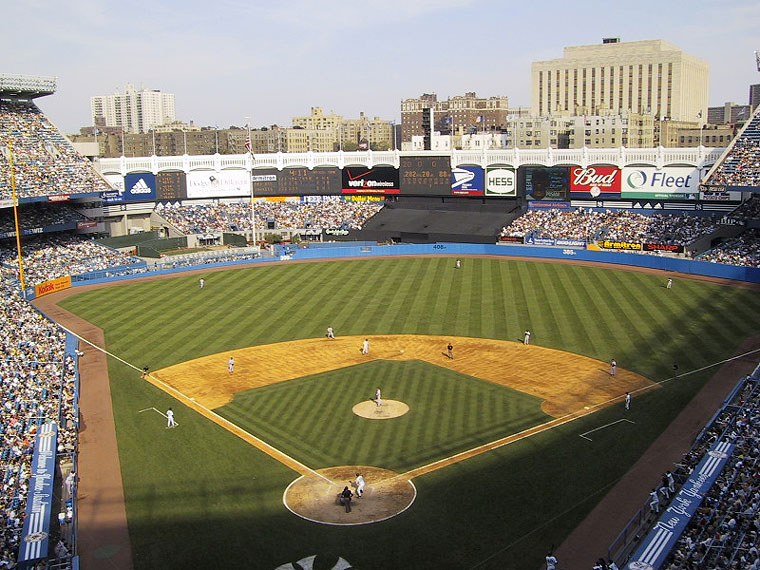
Yankee Stadium Footnotes - Facts & Figures
| |||||||||||||||||||||||||||
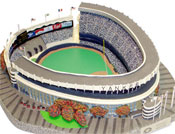
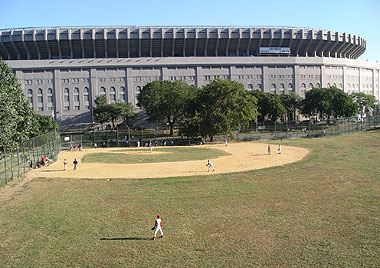
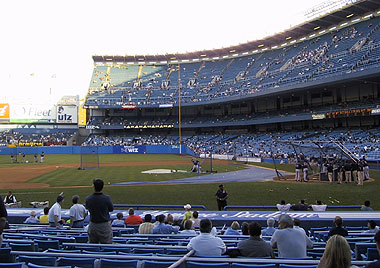
 When Yankee Stadium opened on April 18, 1923 there were 74,200 fans in attendance to see the Babe hit a three-run blast as the Yankees won their first game, 4-1 over the Red Sox. Ruth was the sport’s first marquee drawing card and his mere presence in New York’s new stadium enabled the Yankees to generate revenue superior to their rivals, a trend that continues to this day.
When Yankee Stadium opened on April 18, 1923 there were 74,200 fans in attendance to see the Babe hit a three-run blast as the Yankees won their first game, 4-1 over the Red Sox. Ruth was the sport’s first marquee drawing card and his mere presence in New York’s new stadium enabled the Yankees to generate revenue superior to their rivals, a trend that continues to this day.
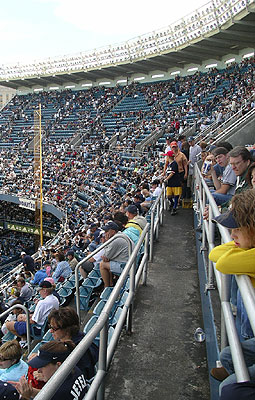 Getting around in the upper deck is no easy task, as the aisle is wide enough for only one person to walk through and two people have to turn sideways to pass each other when heading in opposite directions.
Getting around in the upper deck is no easy task, as the aisle is wide enough for only one person to walk through and two people have to turn sideways to pass each other when heading in opposite directions.
